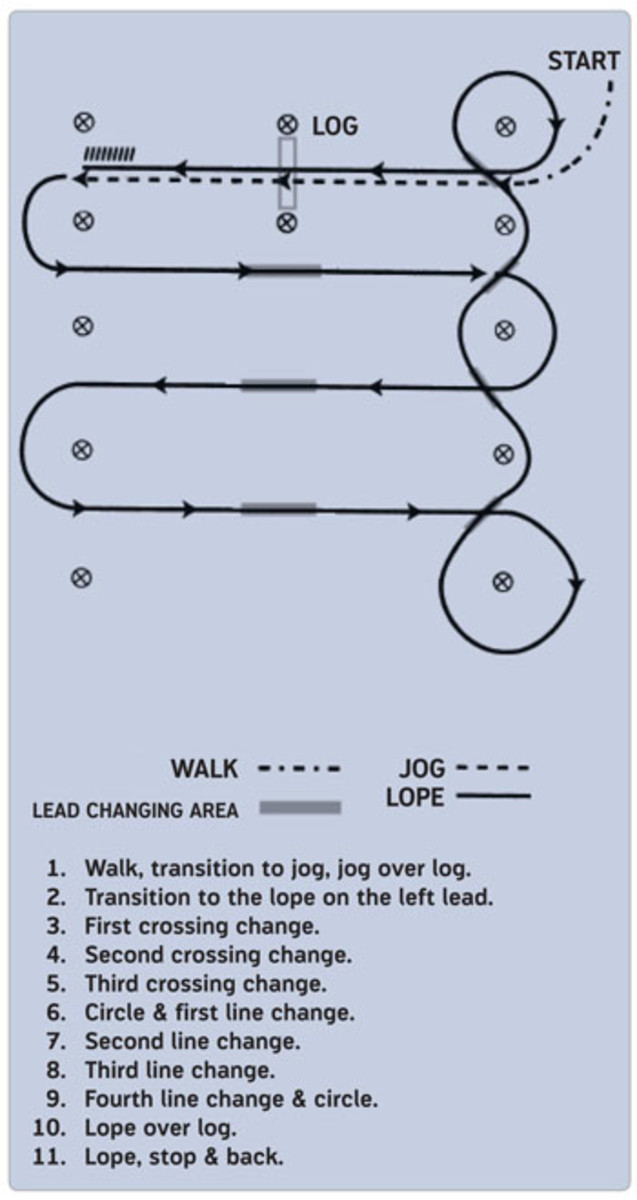Each maneuver is scored from plus one-and-a-half points for excellent, to negative one-and a-half for very poor. Zero represents average. In addition, mistakes on course incur penalties from one-half point for a minor error, to five points for a major error. Starting at 70, you’ll gain or lose points on course.

Enter at a businesslike walk; moseying wastes time. At the first markers, move to the jog. Jogging too early or late incurs penalties, as does being early or late with all maneuvers in this pattern.
Jog a straight line to the center of the log, focusing your eyes up and beyond it and letting your horse find a rhythmic, cadenced stride. If he shuffles, increase his pace a bit to gain some quality of movement and help clear the log. If he ticks the log, you’ll lose a half point, and if he raps it, a full point. If he kicks it hard enough to roll it, he could incur even more penalties.
To avoid penalty, don’t allow your horse to leap into the lope immediately after the log. Instead, keep him tuned to your cues and wait until his nose comes even with the second line of markers. Then, lope a wide path around that marker to establish good pace and rhythm and a straight path across the arena.
Keep a bit of forward pace through your three crossing changes to help your horse execute his best lead changes. Don’t rush him, but don’t allow him to bog down into such a slow pace that he struggles to change leads. It takes an unusual, exceptionally strong horse to produce pretty, correct changes from a crawling pace.
I reward good lead changes, so even if your horse is a mediocre mover, but gives a good effort and gets a correct change, I’ll give you a plus half point. Good movers putting in pretty, correct changes can earn plus one or one-and-a-half points. A really good change is straight, flat, and level. The horse’s body stays so quiet that you’d never know he changed leads if you couldn’t see his legs. He shouldn’t twist from head to tail, or lift his head or hip for the change. He also shouldn’t shift laterally or pin his ears, open his mouth, or drop his face behind the vertical. Getting the lead in front and hind pairs simultaneously is critical to a good score, too.
Placement of all lead changes on course is essential. Performing them early or late incurs penalties—the farther away from the correct spot, the more penalties incurred. Perform changes in the designated zones the diagram depicts. For the crossing changes, stay spatially aware of your position in the arena and let the log at the pattern’s top help indicate the center. With time to set up for a good change, the crossing changes are your chance to wow me, but keep your horse dialed in to your aids and prevent him from changing too early.
Ride the bottom circle fairly deep to set up a good approach to your line changes, and prevent an inadvertent lead change as your horse passes that bottom marker. Keep your line as straight as possible through the line changes, shifting just a few feet to the side of each marker. Think ahead—these changes come at you fast. Also, watch your pace, as some horses tend to rush this line toward the in-gate.
Make your top circle symmetrical with your bottom circle, but don’t waste time going excessively wide. Prevent your horse from throwing in an extra lead change around this marker. Find a straight line to the log’s center and let him clear it without getting in his way. Splitting the log (the log falls between the front or hind pairs of feet as he lopes over) incurs penalties.
Don’t shrug off the halt and back— they’re part of the pattern, and can earn extra points if done well. Halt promptly but softly, square and balanced. Back straight and smoothly at least three steps; five if your horse backs well.
Knowing the challenges of the class, Carla Wennberg has respect and admiration for Western riding horses. Based in Laurinburg, North Carolina, she is a carded judge with the AQHA, NSBA, and NRHA, and a USEF R judge and FEI steward for reining. Carla also coaches the Western and dressage riders for the Saint Andrews Presbyterian College equestrian program.






